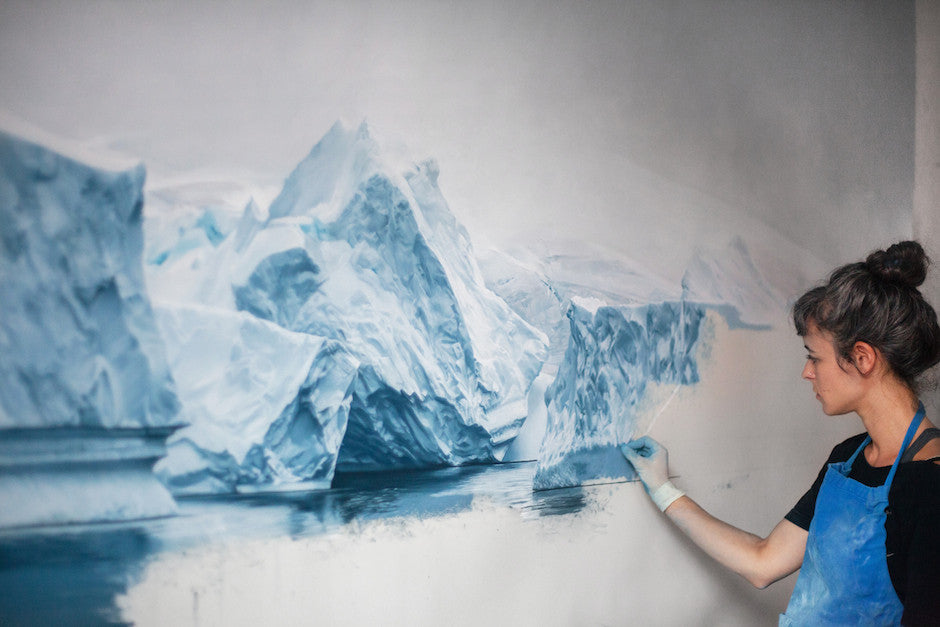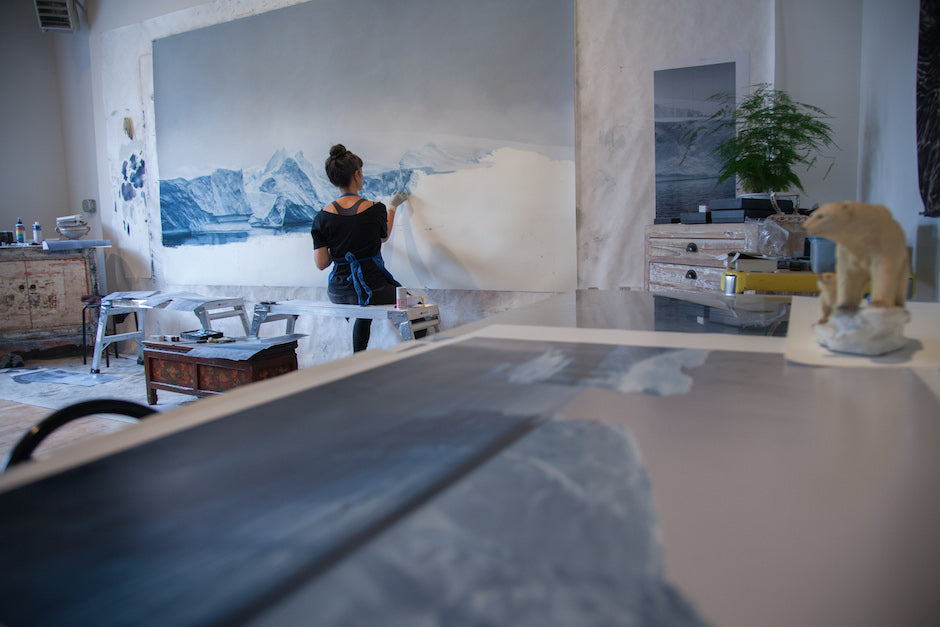Cart Details Should Go Here

Photo by: Quinn Miller-Bedell
There’s something so striking about Zaria Forman’s work that it is almost haunting. It’s beautiful and grand, but it also tells a story, a story that is near and dear to the heart of anyone who is in love with the sea. Forman’s art is more than just a mere spectacle to be stared at in a gallery or a collectors private collection, because Zaria is telling the story of how our environment is changing, how our oceans are being impacted by climate change, and how we will feel the impacts if we don’t make changes.
Based in Brooklyn, New York, Zaria is an adventurer in the truest sense, she has sailed up the NW Coast of Greenland to document the rapidly changing landscape and recently completed an expedition to Antarctica where she was a resident artist on the National Geographic Explorer. We were beyond excited to check in with Zaria to talk about her influences, her travels, and how she uses her art to inspire change.
You were exposed to remote natural environments when you were young. How has that informed your personal work?
The inspiration for my drawings began in my early childhood when I traveled with my family throughout several of the world’s most remote landscapes, which became the subject of my mother's fine art photography. I developed an appreciation for the beauty and vastness of the ever-changing sky and sea. I loved watching a far-off storm on the western desert plains; the monsoon rains of southern India; and the cold arctic light illuminating Greenland's waters.
I have very fond memories of our family trips and consider them a vital part of my upbringing and education. I feel very fortunate that I had the opportunity to see so much of the world, and to learn first-hand about cultures so vastly different from my own. This myriad of experiences instilled in me a love and need to continue exploring and learning for the rest of my life.
 Deception Island, Antarctica - 72’’ x 128’’ Soft Pastel on Paper, 2015
Deception Island, Antarctica - 72’’ x 128’’ Soft Pastel on Paper, 2015
Was the environment always the primary subject in your work, or have you gone through different artistic phases?
I have always been inspired by landscape, but compositionally my work has become more and more detailed over time. It hasn’t been intentional, but looking back, it’s the biggest difference I see in comparing my work from 10 years ago to now. I try to push my own boundaries as much as I can, by attempting compositions that intimidate me, or textures I find difficult to render in pastel. I learn the most when I work outside my comfort zone.
As surfers, the ocean’s ecosystem is very important to us, what initially drew you to the water?
I swam a great deal throughout my childhood. I hardly sailed, and only surfed once in college, I would love to go again though! I have always felt a connection to water, as I think many people do.
I think most human beings are drawn towards water in one way or another. It makes up more than 75% of our bodies, and covers most of the Earth’s surface. We need water to survive, but we also gravitate toward its beauty — the respite, shimmer, and movement it adds to a landscape. I think of water as a metaphor for life - forever transforming, both fearsomely and beautifully. It is an endless source of inspiration to me as it constantly changes, taking on new forms from one instant to the next - a movement I attempt to evoke in my drawings. There will always be more for me to learn about the methods with which water can be conveyed in pastel, and I enjoy that never-ending challenge.
 Photo by: Quinn Miller-Bedell
Photo by: Quinn Miller-Bedell
Do you view your work as a form of environmental activism?
Artists play a critical role in communicating climate change, which is arguably the most important challenge we face as a global community. I have dedicated my career to translating and illuminating scientists’ warnings and statistics with an accessible medium, one that moves us in a way that statistics may not. Neuroscience tells us that humans take action and make decisions based on emotion above all else. Studies have shown that art can impact our emotions more effectively than a scary news report. My drawings explore moments of transition, turbulence, and tranquility in the landscape, allowing viewers to emotionally connect with a place they may never have the chance to visit. I choose to convey the beauty as opposed to the devastation of threatened places. If people can experience the sublimity of these landscapes, perhaps they will be inspired to protect and preserve them.
Tell us about Chasing the Light, your expedition sailing up the Northwest Coast of Greenland.
In August 2012, I led an Arctic expedition up the NW coast of Greenland called “Chasing the Light”. It was the second expedition and the mission was to create art inspired by this dramatic geography. The first, in 1869, was led by the American painter William Bradford. My mother, Rena Bass Forman, had conceived the idea for the voyage, but did not live to see it through. During the months of her illness her dedication to the expedition never wavered and I promised to carry out her final journey.
 Svalbard #33 - 60’’ x 90’’, Soft Pastel on Paper, 2014
Svalbard #33 - 60’’ x 90’’, Soft Pastel on Paper, 2014
How did that trip impact your work?
During this trip to Greenland, I became aware of how serious the climate crisis is. The local Inuits spoke of vast ice fjords that are not freezing as they once did, challenging the lifestyle of the subsistence hunting communities that dot the coastlines. The fjords are the communities’ hunting grounds for seal, walrus, and other animals that provide sustenance, warmth and other crucial items necessary for Arctic survival. Insufficient ice severely limits their hunting grounds. Greenland has no railways, no inland waterways, and virtually no roads between towns. Their major method of transportation is by boat around the coast in summer and by dog sled in winter (which, ten years ago, made up most of the year). Without frozen fjords, their dogs and sleds are rendered useless, and many cannot afford to travel very far by boat. This is just one of enumerable ways the warming Arctic is affecting the Inuit way of life. Learning about all of this instilled in me a need to play a part in solving the crisis, with the skills and passion I have for drawing. Beyond Greenland, the entire planet is being affected. I followed the meltwater from the Arctic to the Equator in an attempt to draw the connection between two seemingly disparate landscapes that are undoubtedly linked.
And now you will travel to Antarctica with National Geographic?
I actually just recently returned from the 5 week expedition to Antarctica. I was the artist-in-residence aboard the National Geographic Explorer with Lindblad Expeditions.
 Lemarie Channel, Antarctica - 44’’ x 60’’ Soft Pastel on Paper, 2015
Lemarie Channel, Antarctica - 44’’ x 60’’ Soft Pastel on Paper, 2015
What else do you have in store for 2016?
My next solo show will take place at Winston Wächter Fine Art’s Seattle location, in February and March of 2017.
I will have work on view in the upcoming PULSE art fair in NYC this March, as well as the Seattle Art Fair in August.
As always, I have a selection of limited edition prints of my drawings that sell exclusively through ArtStar.com, in case anyone is interested. For originals, please contact my studio manager Melanie Reese at zariaformaninfo@gmail.com.
Climate change has obviously and will continue to have major consequences for future generations, if there was one message you could send out to the world in regards to conservation what would it be?
I hope my drawings can facilitate a deeper understanding of the climate crisis, helping us find meaning and optimism in shifting landscapes. I hope my drawings serve as records of landscapes in flux, documenting the transition, and inspiring our global community to take action for the future.